QuestionQUESTION: hi diane my bearded dragon is approx 6/7 months old but iam very concerned, he is not eating at all! he is very lathargic and he seems as if he is really constipated he often tries to pass a stool but is straining very bad. he does manage to sqeeze a drop out,i had a look at it it seems to be white on the outside with a very hard black/brown filling on the inside he has got an appointment on wed but im trying to discover wot it is i was thinking maybe it could either b internal parasites or to many crickets which have blocked him up?? what do u think??
ANSWER: Hi Amy,
Sorry your beardie isn't doing well.
I am including a basic care sheet that I wrote to help people out with their care.
Its not so much too many crickets, but ones that may have been too large for him.
You are correct that it can also be internal parasites.It can also be impaction from eating the substrate, such as sand. Can also be caused by dehydration and also incorrect temperatures...and also lack of proper uvb and of course improper diet(lack of greens/too large of insects/too many hard outer body insects such as mealworms)
Whew!! quite the list, isn't it?
Without proper temperatures they cannot digest foods properly.
Have you tried soaking him in a warm tub with very, very gentle belly massages? Many times that will help them go. Many people also mix a few drops of olive oil with some babyfood fruit and offer with a syringe. Baby food prunes also help. The only problem with using something to help them go is that if it is a foreign body blockage, then the "force" of them trying to go can cause tears to their intestines, stomach and or bowel. If you are positive its not a blockage due to a foreign object(sand,bark,litter,money,etc, etc) then offering some of the babyfood prunes may help soften the stool..the warm bath is also important. Also, try offering some water with an eye dropper or syringe, minus the needle of course.
Prolonged constipation in reptiles can cause a prolapse. If he would happen to prolapse, soak his bottom in a heavy sugar/water mix..many times the mix helps to shrink the tissue, allowing it to go back in place. Also, if a prolapse, a vet is needed asap ...you can take gauze and soak it in the sugar/water solution, and place it on your beardies vent area on the way to the vet...keep the gauze well soaked. It will help prevent drying out of the exposed tissue.
I tell you about what to do in case of a prolapse so that if it does happen, you don't have to waste time trying to find out what to do.
BASIC BEARDED DRAGON CARE:
HOUSING:
For an adult bearded Dragon, a 50 -55 gallon is the smallest recommended tank. For a baby, nothing less than a 30 gallon tank will work for a very short time, so its best to just start out with the adult sized tank....you can add rocks and branches for climbing, being sure to not stack rocks too high to prevent them toppling over. Branches need to be secure. They like to have a hide log or cave too!! All items brought from outside need to be cleaned well before placing them in the BD's tank. To clean them, there are a few methods: to wash in a bleach solution of 1/4 cup of bleach to 1 gallon of water. Let them soak for about an hour, rinse them in hot water several times and then let them dry in the sun until completely dry. If the items are small enough, they can be baked in an over at 200 degrees for about 2 hours, check often to be sure they are not starting to burn. The items can also be boiled(simmered) for 30 minutes or so and then allowed to dry completely before
placing in the tank. I also suggest washing any pet store items such as caves, rocks, branches, etc before placing in the tank as that if the store would happen to have mites they can also be on the items we purchase. Any of the above methods are acceptable for cleaning. CAUTION!!! On store bought branches...be VERY careful with the driftwood pieces that have the holes in them!!! Be sure the holes are small as that if the holes are large, the BD MAY be able to get his head in them but not able to get it back out!!! A secure screen top is necessary for bearded dragons as that also they do not require much height for climbing..they can and do climb!! NEVER USE HEAT ROCKS OR HEATED CAVES!!! They malfunction and cause severe burns and even death!!!!
SUBSTRATES:
Young bearded dragons MUST be kept on paper towels, newspaper or other non particulate(loose) substrate to prevent them from getting any loose substrate into their mouth and swallowing it which can and does cause intestinal blockages.Once the BD is over 10 inches, some people have had good luck using play sand mixed with 50% of peat moss. I prefer the safe substrate of the newspaper, or other non particulate substrate to prevent any problems and also for ease of cleaning.
LIGHTING:
BD's need UVB, which is the special lights that come in fluorescent tubes or special screw in bulbs(mercury vapor)that are designed to produce uvb and heat. The tubes do not produce heat. UVB is needed by the BD
to be able to absorb the calcium in the foods they eat. Without the uvb, they will develop metabolic bone disease.
With the tubes, they must say that they produce BOTH uvb and uva. The uvb needs to be 5% or higher. Repti Sun 5.0 and 10.0(not compact) are TWO of the best uvb tubes on the market. The repti glo 8.0's are a great uvb source also. Arcadia 5.0 (UK), which is the uvb tube available in the UK is a good uvb tube. These need to be positioned 6-8 inches(for the 5.0 and 8.0 and 8-10 inches for the 10.0) over the BD so that they get the uvb that is needed. Recommended length of the tube is 24 inches or more. They need to be replaced every 6-9 months as that they stop producing uvb long before they stop producing light. They need to have access to uvb and basking temperatures for 10-12 hours daily. At night, no white lights!!! There has been new studies that have proven that compact uvb lights, both the spiral/coil type and the ones that look like long "U's" laying on their side and a few other brands are causing what basically amounts to snow blindness in reptiles. To read more on this, you can go to
http://www.uvguide.co.uk/index.htm Here is a link to a letter from RZilla on their product: http://www.zilla-rules.com/assets/006/13278.pdf
There are tubes and bulbs that say ''full spectrum'' but they do not produce any uvb.
On the mercury vapor , they also produce heat. They also produce the uvb and uva. The best on the market now are the
MEGA RAY or the T-Rex. www.reptileuv.com has more information on the Mega Ray lights. When using these, the distance is much greater than the uvb tubes and the directions must be followed that are listed for the light. When using the mercury vapor lights, you don't need to have one light for uvb and one for heat. The Mercury vapor lights provide both.
HEATING AND TEMPERATURES:
Bearded Dragons have specific temperature requirements. For heat when using the uvb producing fluorescent tubes, a regular household lightbulb will work for DAYTIME heat. The wattage needed will vary to each situation such as tank size, room temperatures, air flow. Their basking area temperature must be between 95F and 105F degrees to allow proper digestion of food. Your basking area must be where the uvb light is as well as the heat source. Be sure that the BD cannot get too close to the heat source as that they WILL get burned! The ambient temperature range in the mid 80's . Cool daytime range of normal room temperature of low to mid 70's. Nighttime temperatures in the low to mid 60's is fine. NEVER USE HEAT ROCKS!!!!!!!!!!!!!!!!!!!!! A good digital thermometer is a must. I like using the duel ones with the probe...cost about 15$ at Wal Mart. The probe can be placed in the basking area at the BD's level to monitor this temperature and the main unit can be pla
ced in one of the ambient temperature areas. When reading them, the "out" reading is the probe area.
DIET:
Bearded Dragons eat and need both animal proteins and vegetable matter!!! As young dragons they eat a bit more of the insects. As they get older, as adults their diet is more of the vegetable matter. As young BDs, the diet is about 80% animal proteins and 20% vegetable matter. As they get older, the ratio changes. An adult will eat about 80%-90% vegetable matter and 10-20% animal proteins.
Animal protein sources are: Crickets, superworms, silkworms, roaches, hornworms, waxworms. Waxworms are considered candy to a BD so only feed on occasion in a small amount(2-3 worms). ALL insects must be properly gutloaded for at least 48 hours prior to feeding to the dragon. For crickets and superworms, this can be done with vegetables, plain cereals and commercial foods for the species. Silkworms and the other insects have their own diet needs. Its best to feed the crickets in a separate feeding tank such as a 10 or 20 gallon size tank or container with a well vented lid. This can make it easier for the dragon to catch the crickets and prevents any stray crickets in their "home" tank from deciding to nibble on the BD if he happens to not find them all. If you do feed in his home tank, be sure to place a 1/2 potato in the tank to help prevent the crickets from biting at the BD. ALL insects fed must be no larger than the space between their eyes to prevent choking. Be
sure to dust the insects daily(for dragons up to 14-15 inches) (2x wkly there after)with a good calcium source such as Rep Cal calcium powder with no added Phosphorus. Young BD's up to 4 months of age will eat more crickets than anything. At this age they will usually consume anywhere from 10 to 30+ correctly sized crickets three times a day. Be sure to remove any uneaten crickets that are not consumed in a 15-25 minute time frame. For this reason, its easier to use a separate feeding tank for the bearded dragon. A 10 gallon tank(with a screen top) works well. Its best to offer their "salad" of greens/veggies before offering their morning insect feeding when they are hungry to prevent any problems with them preferring NOT to eat their salad. Their salad consists of Collard greens, mustard greens, turnip greens, dandelion greens...... this is the BASE of the green part of their vegetable diet. To this, for variety you can add arugula, escarole, endive,small amounts of
bok choy or other Asian greens. For the vegetable part of the diet, green beans, butternut squash, acorn squash(other winter squashes are also acceptable) yams, sweet potato. For color, sweet peppers can also be added in a small amount. For baby BD's, using a food processor for the greens and veggies works well. As they get older, greens should never be larger than about an inch x an inch in size. Never feed lettuces as they have no nutritional value. The hard veggies should be either food processed or grated. Fruits can also be offered in small amounts. Good fruits are figs, papaya, melon, blueberries, strawberries, raspberries....and many other fruits... these need to be mashed or chopped. Watermelon is a good source of water for the dragon. Their salad can be dusted once or at the most, twice a month with a good vitamin supplement such as RepCal HerptiVit. This is by no means a complete list of foods the dragons can eat.
You can also offer baby food chicken or small bits of boiled chicken.
Be sure to provide a dish of FRESH drinking water at ALL times!!! Misting their salad will also help get much needed water into them. NEVER FEED any MICE or other mammals to your Dragon!!!
WATER:
As stated above, always provide a dish of drinking water and mist their salad. You can also bathe your dragon a few times a week. (many bathe them daily for "bathroom duties") Temperature of the water should be between 85 and 95 degrees. The depth should never be any deeper than to cover his back when laying FLAT!!! Never leave them unattended at bath time to prevent possible drowning. Many love to soak and swim for 15 minutes or more. Never bathe less than two hours before his basking lights go out. Doing so can cause him to become too chilled, risking the chance of a respiratory infection.
A vet check up is recommended and a fecal sample taken in to be tested for any internal parasites.... To find a qualified vet in your area you can go to
http://www.herpvetconnection.com
http://www.arav.org/ECOMARAV/timssnet/amm/tnt_mdsearch.cfm
http://www.anapsid.org/vets/
More in-depth care info can be found at:
http://www.bio.miami.edu/ktosney/file/BDcare.html
http://www.sundialreptile.com/care%20sheet--bearded%20dragon.htm
http://www.blackninjakitty.com/herps/dragons
Most bearded dragons will take long naps (generally,if they are over a yr) in the fall.. this is called Brumation. is a form of hibernation. You can read more about that at http://www.bio.miami.edu/ktosney/file/BDbrumate.html
---------- FOLLOW-UP ----------
QUESTION: hi diane i have been bathing him it seems to be working slightly, i have a repti glo 5.0 uv light and my heat lamp is a 60watt bulb i only have a small cube vivarium but my bd is about 7/8 inches long with tail is that ok?? he is not eating anything at all! iv tryed giving him some carrots,peas, and green beans but he does not want anything. there could be a possibility that he has eaten sand which is what i use in his vivarium, he has got a vet appointment on wed but in the meantime is there banything i can do to help?? also when he does pass a stool its only a tiny bit and it smells bad?
ANSWER: Hi Amy,
7-8 inches total length is pretty small for his age. He should be about double that, or even more. Try allowing him some free roam time to get good exercise which may help him pass stool...
Do you have your uvb at the recommended distance in the care sheet I gave you? Beardies eat plant matter more so than the veggies..do try the recommended greens.
Sand can be a real problem....remove it and use paper towels or cloth towels...
I would offer water as I recommended VIA eye dropper
You can probably try as small amount of the babyfood prunes with the syringe or eye dropper also...
Double check your temperatures..make sure that the basking temperatures are at the recommended gradient. Incorrect temperatures are a biggie with causing them to not eat and other problems.
Continue with the bathing and massage his stomach gently from under his front legs down toward his vent...The smelling bad on the poop..that's generally a good sign that there are internal parasites.
---------- FOLLOW-UP ----------
QUESTION: hi diane.i had a very sleepness night, i am really worried i really dnt want him to die! i have been bathing him like u said and massaging but nothing has happened, i had a feel of his belly today and it seems as if he has these hard lumps inside of him, do u think that sounds more like constipationor internal parasites?
AnswerHi Amy,
If there is a blockage it can be caused by the internal parasites or by something else.
I would call the vet and tell them you need to get him earlier for the vet visit. If they cannot see him sooner, then you may want to try a different vet. Any vet may want to do an x ray to see if they can see a problem. Many times an x ray will tell if it is a blockage of foreign matter or fecal matter.
There is really nothing more that I can tell you other than what I have in my past replies.
Are you positive that your beardie is a male? I can't see it happening at your beardies size or age, (would be very odd and uncommon) but if a female, that may be older than you think, she could be gravid(forming eggs). As I said, I can't imagine it being that, but its something that would also cause what you are describing with the not eating, etc.
Get a vet appointment for as soon as you can to find out what is going on.
Continue to offer the water with an eye dropper.

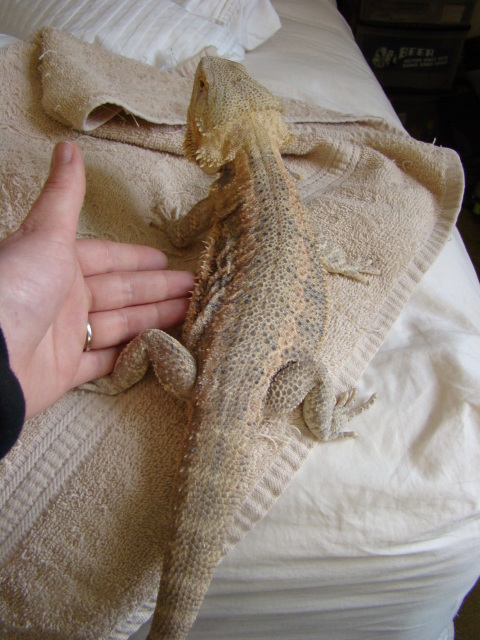 scared, lethargic and not eating beardie- Came on suddenly
QuestionQUESTION: Ive had Brutus- a bearded dragon for
scared, lethargic and not eating beardie- Came on suddenly
QuestionQUESTION: Ive had Brutus- a bearded dragon for
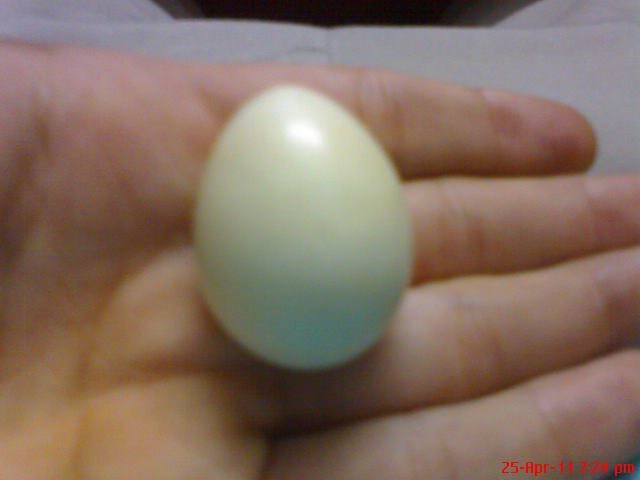 egg
Question
egg
Hello,i just recently found an egg and i n
egg
Question
egg
Hello,i just recently found an egg and i n
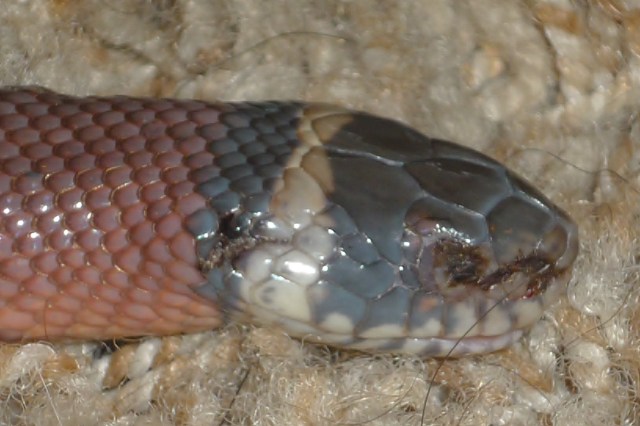 injured wil caught milksnake
Questionpoor little fella
QUESTION: found injure
injured wil caught milksnake
Questionpoor little fella
QUESTION: found injure
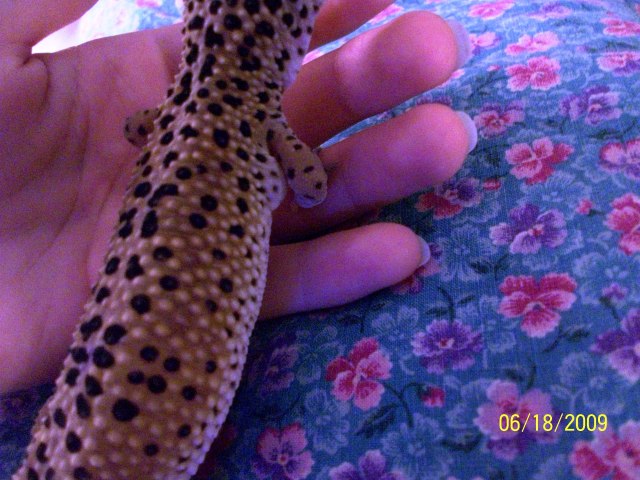 I forgot budys picture
Questionbudy
QUESTION: Hi sorry I forgot to atta
I forgot budys picture
Questionbudy
QUESTION: Hi sorry I forgot to atta
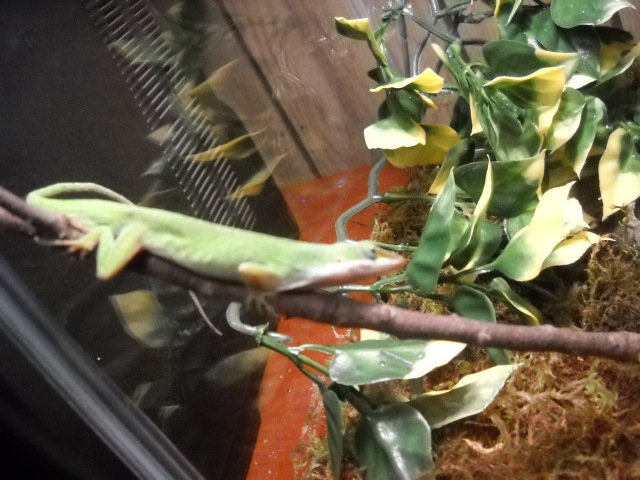 My green anole is dehydrated
QuestionQUESTION: i just sent u a message before i cont
My green anole is dehydrated
QuestionQUESTION: i just sent u a message before i cont